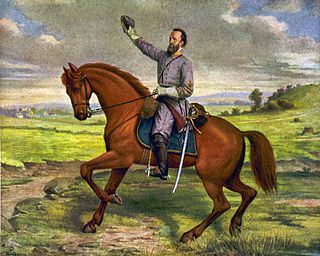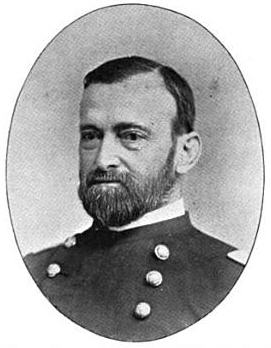
The First Battle of Winchester, fought on May 25, 1862, in and around Frederick County, Virginia, and Winchester, Virginia, was a major victory in Confederate Army Maj. Gen. Thomas J. "Stonewall" Jackson's Campaign through the Shenandoah Valley during the American Civil War. Jackson enveloped the right flank of the Union Army under Maj. Gen. Nathaniel P. Banks and pursued it as it fled across the Potomac River into Maryland. Jackson's success in achieving force concentration early in the fighting allowed him to secure a more decisive victory which had escaped him in previous battles of the campaign.

Jackson's Valley campaign, also known as the Shenandoah Valley campaign of 1862, was Confederate Maj. Gen. Thomas J. "Stonewall" Jackson's spring 1862 campaign through the Shenandoah Valley in Virginia during the American Civil War. Employing audacity and rapid, unpredictable movements on interior lines, Jackson's 17,000 men marched 646 miles (1,040 km) in 48 days and won several minor battles as they successfully engaged three Union armies, preventing them from reinforcing the Union offensive against Richmond.

Turner Ashby Jr. was an American officer. He was a Confederate cavalry commander in the American Civil War.

The Battle of Hancock was fought during the Confederate Romney Expedition of the American Civil War on January 5 and 6, 1862, near Hancock, Maryland. Major General Stonewall Jackson of the Confederate States Army, commanding his own Valley District and Brigadier General William W. Loring's force known as the Confederate Army of the Northwest, began moving against Union Army forces in the Shenandoah Valley area on January 1. After light fighting near Bath, Virginia, Jackson's men reached the vicinity of Hancock late on January 4 and briefly fired on the town with artillery. Union Brigadier General Frederick W. Lander refused a Confederate request to surrender on January 5, and that day and the next saw exchanges of artillery fire between the two sides. The Confederates burned a bridge on the Baltimore and Ohio Railroad on January 5, but withdrew on the 7th. Jackson later moved against Romney, Virginia, and occupied the town on January 15 after Union soldiers abandoned it. Romney was ordered abandoned on January 30 by the Confederate States Secretary of War after Loring complained about Jackson's orders.

The First Battle of Kernstown was fought on March 23, 1862, in Frederick County and Winchester, Virginia, the opening battle of Confederate Maj. Gen. Thomas J. "Stonewall" Jackson's campaign through the Shenandoah Valley during the American Civil War.

The Battle of Front Royal, also known as Guard Hill or Cedarville, was fought on May 23, 1862, during the American Civil War, as part of Jackson's Valley campaign. Confederate forces commanded by Major General Thomas J. "Stonewall" Jackson were trying to keep Union forces engaged in the Shenandoah Valley to prevent them from joining the Peninsula campaign. After defeating Major General John C. Frémont's force in the Battle of McDowell, Jackson turned against the forces of Major General Nathaniel Banks.

The Valley campaigns of 1864 began as operations initiated by Union Lieutenant General Ulysses S. Grant and resulting battles that took place in the Shenandoah Valley of Virginia during the American Civil War from May to October 1864. Some military historians divide this period into three separate campaigns. This article considers them together, as the campaigns interacted and built upon one another.
The town of Romney, Virginia, traded hands between the Union Army and Confederate States Army no fewer than 10 times during the American Civil War, assuming the occupying force spent at least one night in the town. The story of the small town is emblematic of the many military campaigns that swept through western Virginia and, later, the new state of West Virginia.

The 33rd Virginia Infantry Regiment was an infantry regiment raised in the Commonwealth of Virginia for service in the Confederate States Army during the American Civil War. It was a part of the famed "Stonewall Brigade," named for General Stonewall Jackson.

The eastern theater of the American Civil War consisted of the major military and naval operations in the states of Virginia, West Virginia, Maryland, and Pennsylvania, the District of Columbia, and the coastal fortifications and seaports of North Carolina.

The city of Winchester, Virginia, and the surrounding area, were the site of numerous battles during the American Civil War, as contending armies strove to control the lower Shenandoah Valley. Winchester changed hands more often than any other Confederate city.

The Second Corps of the Army of Northern Virginia was a military organization within the Confederate Army of Northern Virginia during much of the American Civil War. It was officially created and named following the Battle of Sharpsburg in 1862, but comprised units in a corps organization for quite some time prior to that. The Second Corps developed a reputation for hard fighting under famed early commander Thomas J. "Stonewall" Jackson.

William Wing Loring was an American soldier who served in the armies of the United States, the Confederacy, and Egypt.

The 7th Virginia Cavalry Regiment also known as Ashby's Cavalry was a Confederate cavalry regiment raised in the spring of 1861 by Colonel Angus William McDonald The regiment was composed primarily of men from the counties of the Shenandoah Valley as well as from the counties of Fauquier and Loudoun. Two companies contained men from the border counties of Maryland.
The Winchester and Potomac Railroad (W&P) was a railroad in the southern United States, which ran from Winchester, Virginia, to Harpers Ferry, West Virginia, on the Potomac River, at a junction with the Baltimore and Ohio Railroad (B&O). It played a key role in early train raids of the B&O during the beginning months of the American Civil War.
The Army of the Northwest was a Confederate army early in the American Civil War.

Samuel Breck was an officer in the United States Army who served as Adjutant General of the U.S. Army from 1897 to 1898.
James Boggs was a brigadier general in the Virginia militia, who served along with the Confederate States Army in northwestern Virginia at various times during 1861 and early 1862 in the American Civil War. Boggs's men participated in Stonewall Jackson's attacks on the towns of Romney and Bath, later Berkeley Springs, now in West Virginia in early January 1862. Debilitated from his responsibilities and the harsh winter weather at his advanced age, Boggs's health failed and he died on January 28, 1862.
James Harvey Carson was a brigadier general in the Virginia militia, who served along with the Confederate States Army in northwestern Virginia at various times during 1861 and early 1862 in the American Civil War. Carson's men were part of Stonewall Jackson's force that moved to take the town of Bath, later Berkeley Springs, now in West Virginia, on January 3, 1862.
Gilbert Simrall Meem was a Virginia farmer and politician who served in both houses of the Virginia General Assembly, as well as became a brigadier general in the Virginia militia and served along with the Confederate States Army in northwestern Virginia and what became West Virginia during the American Civil War. Meem's men participated in Stonewall Jackson's attacks on the towns of Romney and Bath, later Berkeley Springs, now in West Virginia in early January 1862. After the brigade went into winter quarters in Martinsburg, now West Virginia, Meem resigned his commission on February 1, 1862, then served in the Shenandoah County, Virginia, local government during the war and in the Virginia Senate following the war, before moving to Seattle, Washington, and becoming its postmaster in the administration of President Grover Cleveland, where he became a prominent citizen before his death.















